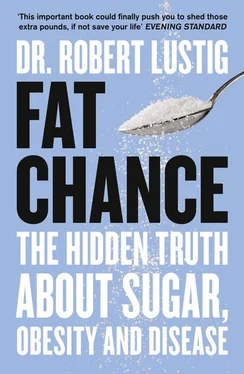While we’re getting fatter, we’re also getting sicker. Our risk for illness is increasing faster than the increase in obesity. Indeed, the cluster of chronic metabolic diseases termed metabolic syndrome – which includes obesity, type 2 diabetes, hypertension (high blood pressure), lipid (blood fat) disorders, and cardiovascular (heart) disease – is snowballing by leaps and bounds. And then there are the other obesity-associated metabolic diseases, such as nonalcoholic fatty liver disease, kidney disease, and polycystic ovarian syndrome. Add to that the other comorbidities (related medical conditions) associated with obesity, such as orthopedic problems, sleep apnea, gallstones, and depression, and the medical devastation associated with the obesity pandemic is staggering. Every one of these diseases has become more prevalent over the past thirty years. What’s more, all of them are now found in children as young as five years old. We even have an epidemic of obese six-month-olds! [1] J. Kim et al., “Trends in Overweight from 1980 Through 2001 Among Preschool-Aged Children Enrolled in a Health Maintenance Organization,” Obesity 14 (2006): 1164–71.
The human damage in this scourge of metabolic syndrome is showing. In 2005 one study showed that despite the increased availability of medical care, our children will be the first generation of Americans who will die earlier than their forebears. [2] S. J. Olshansky et al., “A Potential Decline in Life Expectancy in the United States in the 21st Century,” New Engl. J. Med. 352 (2005): 1138–45.
The study placed the blame squarely on the obesity epidemic. In the United States, quality-adjusted life years lost to obesity have more than doubled from 1993 to 2008. Emergency rooms are taking care of forty-year-old heart attack victims. Teens with type 2 diabetes used to be unheard of; now they are one third of all new diagnoses of diabetes. In the United States alone, 160,000 bariatric surgeries (to reduce the size of the stomach) are performed per year, at an average cost of $30,000 per surgery. Over 40 percent of death certificates now list diabetes as the cause of death, up from 13 percent twenty years ago.
The loss in American productivity due to time off from work is staggering, the waste in medical expenditures ($147 billion per year) is breaking the bank, and this amount is predicted to increase to $192 billion by the end of the decade. Guess what? There’s no money to pay for it all. The Affordable Care Act (ACA, or “Obamacare”) is going to put thirty-two million sick people on the insurance rolls by 2019. The president says we’ll make up for the costs in savings from preventative care. However, it is unlikely to improve our health in any significant way, as there are no provisions for the prevention of chronic disease, most notably those that attend obesity. How do you prevent all the ravages of chronic metabolic disease when we bust the scales and when the statistics show no sign of improvement? It’s often been said that we wouldn’t need health care reform if we had obesity reform.
It would be one thing if obesity were an isolated problem in America, but it’s happening everywhere. The obesity pandemic has expanded the world’s collective waistline. The World Health Organization (WHO) has shown that the percentage of obese humans globally has doubled in the past twenty-eight years. In fact, obesity’s contribution to the burden of chronic disease has been equal to if not greater than that of smoking. Even people in developing countries are obese. After only one decade, there are now 30 percent more people who are obese than are undernourished worldwide. The WHO reported in 2008 that approximately 1.5 billion adults were overweight and at least 400 million were obese globally [3] World Health Organization, Fact Sheet: Obesity and Overweight (2011), www.who.int/mediacentre/factsheets/fs311/en/.
; these numbers are projected to reach about 2.3 billion and 700 million, respectively, by 2015. In September 2011 the UN General Assembly declared that non-communicative diseases (diabetes, cancer, and heart disease) are now a greater threat to world health than are infectious diseases, including in the developing world (see chapter 22). Is the whole world now composed of gluttons and sloths? Over the next fifteen years, these diseases will cost low- and middle-income countries more than $7 trillion. [4] UN General Assembly, “Prevention and Control of Non-Communicable Diseases,” New York, 2010.
People are dying earlier, and national economies are losing billions of dollars in lost productivity while governments pay for the medical expenditures. Millions of families end up in poverty, guaranteeing that the cycle will not be reversed.
For the 55 percent of adults who are overweight or obese, listen up. I’m talking to you , at a doctor-to-patient level, at a person-to-person level. Obesity is not an automatic death sentence. A full 20 percent of morbidly obese persons are metabolically healthy and have normal life spans. [5] J. M. Chan et al., “Obesity, Fat Distribution, and Weight Gain as Risk Factors for Clinical Diabetes in Men,” Diabetes Care 17 (1994): 961–69.
As for the other 80 percent, you don’t have to be in poor health; everyone has it within his reach to improve his health and regain those years the actuaries say will be lost. But success in doing so depends on identifying the cause of the problem, assessing your metabolic risk, and changing your biochemistry. Okay, full disclosure: despite your best efforts, you may never lose your stubborn subcutaneous fat (the fat that pads your thighs and derrière). And if you do, you’ll gain it back in short order – unless you become a gym rat, because vigorous exercise is the only rational way to prevent weight regain (see chapter 13). In fact, if you lose meaningful amounts of subcutaneous fat and keep it off for more than a year, I’ll be shocked. Pleasantly so, but shocked nonetheless.
For the 45 percent of adults who are normal weight, pay attention. You either sneer at or pity the other 55 percent of your brethren who take up two seats on the bus. You look down on them as weak, overindulgent, and lazy. You resent them, and you show it financially and socially. You’re indignant that they cost you money. And you think you’re out of the woods and home free. You’ve been told that you’ll live a long and happy life. Whatever you’re doing, it must be right. For those of you who are “naturally” thin, you’ve been told that you have great genes and can consume all the soft drinks and Twinkies you want without gaining a pound or getting sick. Would that it were true. A few years ago, you were the majority of Americans. Now you’re the minority. And you’re losing your percentage year by year.
This means that many of you are flipping – that is, gaining weight and going over to the dark side. Indeed, current projections suggest that by 2030, the United States will be 65 percent overweight and 165 million American adults will be obese. [6] S. L. Gortmaker et al., “Changing the Future of Obesity: Science, Policy, and Action,” Lancet 378 (2011): 838–47.
The 2008 movie Wall-E is a prophecy: that’s where we’re all headed. We’ll all be so fat, we’ll have to ride around on little scooters, just like at Walmart. And as you get older, your risk for gaining weight keeps going up. Your genes won’t change, but your biochemistry will. So, if you’re flipping (which more and more of you are), something must be sending you over to the “dark side.” And if that’s not your fate, it will be that of your children. Nobody knows this better than I, because I take care of those children every day.
Here’s the kicker. Being thin is not a safeguard against metabolic disease or early death. Up to 40 percent of normal-weight individuals harbor insulin resistance – a sign of chronic metabolic disease – which will likely shorten their life expectancy. Of those, 20 percent demonstrate liver fat on an MRI of the abdomen (see chapter 8). [7] K. C. Sung et al., “Interrelationship Between Fatty Liver and Insulin Resistance in the Development of Type 2 Diabetes,” J. Clin. Endocrinol. Metab. 96 (2011): 1093–97.
Liver fat, irrespective of body fat, has been shown to be a major risk factor in the development of diabetes. You think you’re safe? You are so screwed. And you don’t even know it.
Читать дальше












